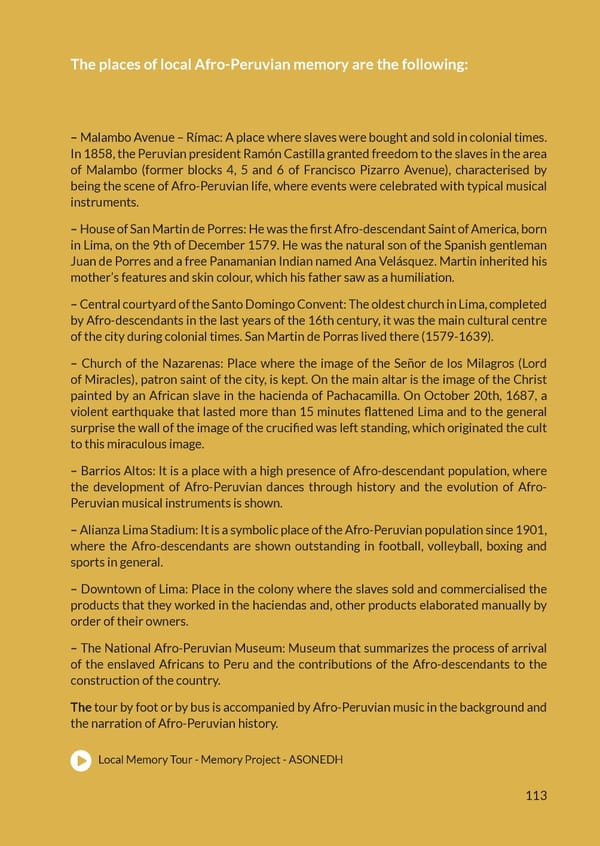The places of local Afro-Peruvian memory are the following: – Malambo Avenue – Rímac: A place where slaves were bought and sold in colonial times. In 1858, the Peruvian president Ramón Castilla granted freedom to the slaves in the area of Malambo (former blocks 4, 5 and 6 of Francisco Pizarro Avenue), characterised by being the scene of Afro-Peruvian life, where events were celebrated with typical musical instruments. – House of San Martin de Porres: He was the first Afro-descendant Saint of America, born in Lima, on the 9th of December 1579. He was the natural son of the Spanish gentleman Juan de Porres and a free Panamanian Indian named Ana Velásquez. Martin inherited his mother’s features and skin colour, which his father saw as a humiliation. – Central courtyard of the Santo Domingo Convent: The oldest church in Lima, completed by Afro-descendants in the last years of the 16th century, it was the main cultural centre of the city during colonial times. San Martin de Porras lived there (1579-1639). – Church of the Nazarenas: Place where the image of the Señor de los Milagros (Lord of Miracles), patron saint of the city, is kept. On the main altar is the image of the Christ painted by an African slave in the hacienda of Pachacamilla. On October 20th, 1687, a violent earthquake that lasted more than 15 minutes flattened Lima and to the general surprise the wall of the image of the crucified was left standing, which originated the cult to this miraculous image. – Barrios Altos: It is a place with a high presence of Afro-descendant population, where the development of Afro-Peruvian dances through history and the evolution of Afro- Peruvian musical instruments is shown. – Alianza Lima Stadium: It is a symbolic place of the Afro-Peruvian population since 1901, where the Afro-descendants are shown outstanding in football, volleyball, boxing and sports in general. – Downtown of Lima: Place in the colony where the slaves sold and commercialised the products that they worked in the haciendas and, other products elaborated manually by order of their owners. – The National Afro-Peruvian Museum: Museum that summarizes the process of arrival of the enslaved Africans to Peru and the contributions of the Afro-descendants to the construction of the country. The tour by foot or by bus is accompanied by Afro-Peruvian music in the background and the narration of Afro-Peruvian history. Local Memory Tour - Memory Project - ASONEDH 113
 MemoryHandbook new Page 112 Page 114
MemoryHandbook new Page 112 Page 114